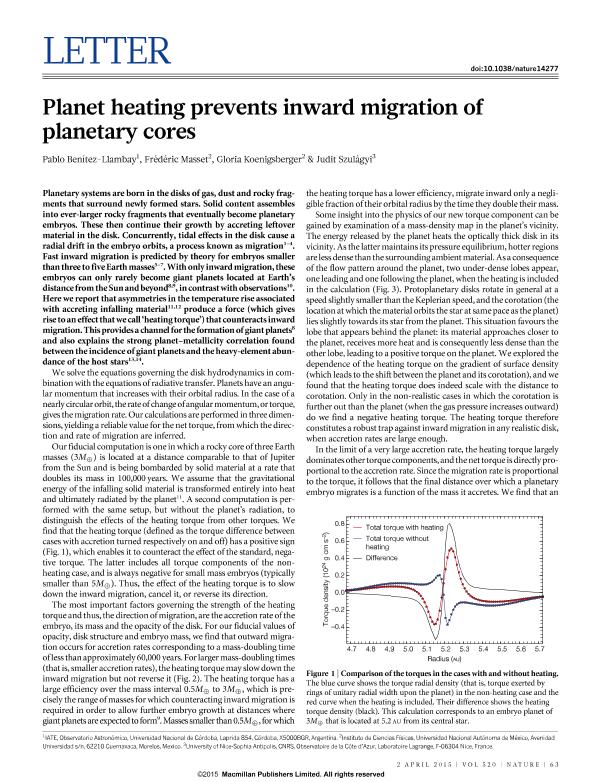Mostrar el registro sencillo del ítem
dc.contributor.author
Benítez Llambay, Pablo

dc.contributor.author
Masset, Frédéric
dc.contributor.author
Koenigsberger, Gloria
dc.contributor.author
Szulágyi, Judit
dc.date.available
2019-02-05T15:34:32Z
dc.date.issued
2015-04
dc.identifier.citation
Benítez Llambay, Pablo; Masset, Frédéric; Koenigsberger, Gloria; Szulágyi, Judit; Planet heating prevents inward migration of planetary cores; Nature Publishing Group; Nature; 520; 7545; 4-2015; 63-65
dc.identifier.issn
0028-0836
dc.identifier.uri
http://hdl.handle.net/11336/69410
dc.description.abstract
Planetary systems are born in the disks of gas, dust and rocky fragments that surround newly formed stars. Solid content assembles into ever-larger rocky fragments that eventually become planetary embryos. These then continue their growth by accreting leftover material in the disk. Concurrently, tidal effects in the disk cause a radial drift in the embryo orbits, a process known as migration. Fast inward migration is predicted by theory for embryos smaller than three to five Earth masses. With only inward migration, these embryos can only rarely become giant planets located at Earth's distance from the Sun and beyond, in contrast with observations. Here we report that asymmetries in the temperature rise associated with accreting infalling material produce a force (which gives rise to an effect that we call 'heating torque') that counteracts inward migration. This provides a channel for the formation of giant planets and also explains the strong planet-metallicity correlation found between the incidence of giant planets and the heavy-element abundance of the host stars.
dc.format
application/pdf
dc.language.iso
eng
dc.publisher
Nature Publishing Group

dc.rights
info:eu-repo/semantics/openAccess
dc.rights.uri
https://creativecommons.org/licenses/by-nc-sa/2.5/ar/
dc.subject
.
dc.subject.classification
Astronomía

dc.subject.classification
Ciencias Físicas

dc.subject.classification
CIENCIAS NATURALES Y EXACTAS

dc.title
Planet heating prevents inward migration of planetary cores
dc.type
info:eu-repo/semantics/article
dc.type
info:ar-repo/semantics/artículo
dc.type
info:eu-repo/semantics/publishedVersion
dc.date.updated
2019-02-04T13:02:25Z
dc.journal.volume
520
dc.journal.number
7545
dc.journal.pagination
63-65
dc.journal.pais
Reino Unido

dc.journal.ciudad
Londres
dc.description.fil
Fil: Benítez Llambay, Pablo. Consejo Nacional de Investigaciones Científicas y Técnicas. Centro Científico Tecnológico Conicet - Córdoba. Instituto de Astronomía Teórica y Experimental. Universidad Nacional de Córdoba. Observatorio Astronómico de Córdoba. Instituto de Astronomía Teórica y Experimental; Argentina
dc.description.fil
Fil: Masset, Frédéric. Universidad Nacional Autónoma de México; México
dc.description.fil
Fil: Koenigsberger, Gloria. Universidad Nacional Autónoma de México; México
dc.description.fil
Fil: Szulágyi, Judit. Centre National de la Recherche Scientifique; Francia
dc.journal.title
Nature

dc.relation.alternativeid
info:eu-repo/semantics/altIdentifier/doi/https://dx.doi.org/10.1038/nature14277
dc.relation.alternativeid
info:eu-repo/semantics/altIdentifier/url/https://www.nature.com/articles/nature14277
Archivos asociados
